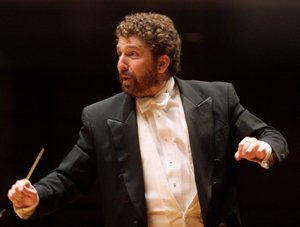By Timothy Robson

Richard Wagner composed the libretto and score to The Flying Dutchman (Der fliegender Holländer) from 1841-1843 while he and his wife Minna were living in Paris, having fled Wagner’s debtors in Riga, Russia (now Latvia). Wagner composed the opera in one long act, without intermission, although he later revised the work slightly to create three acts, bowing to audience expectations. Even with the changes, the first audiences found the music and scenario quite daring, but The Flying Dutchman soon became Wagner’s first operatic success.
The overture presents all of the “big tunes” from the opera, combined and developed as a preview of what was to come. It opens with stormy depictions of the North Sea and the character of the Dutchman, who is cursed to sail the sea forever but allowed to come ashore once every seven years in search of a faithful woman, who can redeem him by dying for him. That woman turns out to be Senta, whose second act ballad provides a few moments of calm. We also hear the songs of the sailors. Senta’s leap into the sea redeems the Dutchman, and the overture ends in a radiant apotheosis.
Asher Fisch, one of whose specialties is Wagner, having burnished his credentials in the Seattle Opera Ring production of 2013, led a dark and brooding performance with powerful brass fanfares. Even in the movement’s most violent moments, the drama was kept under control, with orchestral lyricism winning out.
The breadth of violinist Isabelle Faust’s musical interests is remarkable. She is knowledgeable about historically-informed performance practice, and has recorded the Bach Sonatas and Partitas for solo violin; she performs the standard concerto repertoire; and she also frequently performs and records contemporary music as diverse as Messiaen, Ligeti, Morton Feldman and Jörg Widmann. She has the reputation of being an intellectual performer – and I mean that as a compliment – so I was interested to hear how she would handle the very familiar Mendelssohn concerto.
Her approach was almost of chamber music scale, and Asher Fisch kept the orchestra under tight rein not to cover Faust’s relatively small, sweet tone. Her interpretation was sensitive, harking back to the refinement of the Classical era. The tempi never lagged, although the second movement had an exquisite sense of stillness and calm. She was certainly capable of a powerful sound, but it was always in the context of her overall interpretation. Only at a few moments in the third movement did there seem to be disagreements about the tempo. This was a performance that proved that it is not necessary to blast one’s way through a musical work to make an effect; indeed, the quiet playing here was arresting. This was an auspicious debut, worthy of a return engagement.
Fisch kept the momentum going for a performance of Beethoven’s seventh symphony that emphasized clarity of texture and tempi that never lingered. The first movement was robust, with pervasive dance-like rhythms. The second movement’s rhythmic ostinato long-short-short propelled the variations above it, in which Beethoven’s masterful orchestrations take advantage of the spatial aspects of the orchestra’s sound. Fisch recognized the surprise elements of the scherzo/trio movement, in which Beethoven keeps the listener off-balance in knowing what is coming next. The extravagant fourth movement was exuberant throughout, bringing a highly successful concert to a joyful close.
Published on ClevelandClassical.com July 15, 2014.
Click here for a printable copy of this article.




